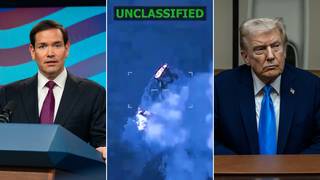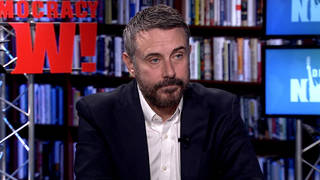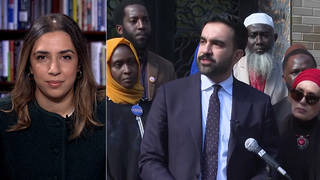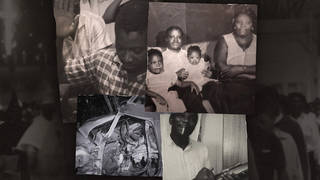
Historian and journalist Betsy Phillips discusses her new book, Dynamite Nashville: Unmasking the FBI, the KKK, and the Bombers Beyond Their Control, which chronicles three bombings in 1957, 1958 and 1960 aimed at supporters of the civil rights movement in Nashville. The book has sparked a reopening of the formerly cold cases, the likely perpetrators of which Phillips names in her book. Phillips details what she uncovered through her research about the connections between the white supremacist terror campaign of the previous century and ongoing neo-Nazi activity in Nashville and the U.S. today.
Transcript
AMY GOODMAN: This is Democracy Now!, democracynow.org. I’m Amy Goodman.
We end today’s show in Nashville, Tennessee, where the mayor recently introduced four new measures that attempt to protect free speech rights while also addressing what some call the city’s “Nazi problem.” Nashville Mayor Freddie O’Connell also announced in July he’s reopening a police investigation into three unsolved bombings in Nashville from the civil rights era.
This all comes after Nashville journalist Betsy Phillips published a new book into the attacks titled Dynamite Nashville: Unmasking the FBI, the KKK, and the Bombers Beyond Their Control. In her book, Phillips writes, quote, “Just as Nashville was where Civil Rights icons like John Lewis, James Lawson, and Diane Nash began, Nashville is also where a network of racial terrorists began,” unquote.
Around the same time the book just came out, neo-Nazis marched through Nashville’s downtown for the third time this year. Many carried U.S. and Confederate flags. A viral video shows them yelling racist slurs at a group of Black children. After the attack, the children and their parents spoke out. This is 10-year-old Detonio Wilson and his mother sharing the advice she gave him.
DETONIO WILSON: I feel like it was racist because they were just saying bad words to us, and the police didn’t do nothing. They were just telling us to go home.
ASHTON LEE: Don’t leave it stuck in the back of your minds like that, because it will mess you up tremendously, like for a long time.
AMY GOODMAN: For more on this, I spoke with Betsy Phillips about her new book, Dynamite Nashville, for which she spent nearly a decade trying to uncover the truth about the three civil rights-era bombings in Nashville that all went unsolved: the Hattie Cotton School in '57 as it was set to integrate; the Nashville Jewish Community Center in ’58, which had held integrated activities; and the home of leading civil rights lawyer and city councilmember Z. Alexander Looby in 1960. I asked Phillips to follow a trajectory from this year's neo-Nazi marches in Nashville back to the unsolved bombings that are now the focus of a newly assigned cold case detective with the Nashville police.
BETSY PHILLIPS: Well, one of the reasons that I’m really excited about the mayor reopening these investigations is that the Nashville police can do something now that Nashville police in the '50s could not do, which is make a bunch of long-distance calls. So, one of the biggest, like, impediments to solving these cases back in the day, and one that I, you know, just because I have email, could easily overcome, is that I could contact Florida and see what records they had. I could easily email Birmingham and see what they had. And that's just not something that was really possible in the 1950s.
So, while everybody — like, throughout the South, they knew that there was this group, the Confederate Underground, because after they bombed something, they would call and take credit. So, municipalities throughout the South wanted the FBI to step in, because they’re like, “You have funding, and you have the ability to do these kind of interstate investigations. And look, they’re using the same name throughout the South for both these bombings of Black institutions and bombings of Jewish institutions. So, you figure out who they are, and we’ll stop them.” And the FBI just repeatedly was like, “No, these are local matters. They’re unconnected. They don’t have anything to do with each other.” And so, they were just able to continue their activities. And, you know, members of this network were even present in Birmingham in the week before the 16th Street Baptist Church bombing. So, you know, the implications of not catching them while they were in Nashville were enormous for the nation. But —
AMY GOODMAN: So, let’s get real specific. Of course, the —
BETSY PHILLIPS: Sure.
AMY GOODMAN: — Birmingham bombing was 1963 in Alabama. Let’s start with the Hattie Cotton School in 1957 that was set to integrate. What happened?
BETSY PHILLIPS: Yes, right. So, John Kasper, who was a racist activist, had been in town all month basically fomenting discord. And racists throughout the South, like Asa Carter, for instance, and Bill Hendrix from down in Florida, had come up to help him. The FBI heard from an informant, “Hey, these guys have dynamite. They’re building a bomb.” And then they heard again from the informant, “My friend has seen the dynamite.” The FBI did not share this with the Nashville police.
So, the day of school integration, protesters went to all the schools that they knew were integrating. No one knew ahead of time that Hattie Cotton was integrating, because Patricia Watson’s family didn’t preregister her. They just registered her the day of. So, Hattie Cotton didn’t have the same kinds of police presence that these other schools had. And that evening, when — after the first day of school, when police were trying to figure out, you know, like, “Well, where do we need to be? What do we need to be keeping an eye on?” they only went to the schools where there had been mild riots — I don’t know how to better put that — demonstrations that day. And since there hadn’t been demonstrations at Hattie Cotton, they left it a sitting duck. So, that night, at right about just after midnight, the school blew up. The whole east wing was blown up.
And then, in the aftermath of that, one of the things that got me hooked on this, where I was like, “Whoa, this is much more complicated than I realized,” because in the FBI records, they talked about, like, “We have these witnesses. We are not sharing them with the Nashville police.” And then, in the FBI file, there’s a memo outlining, like, “Yes, we had this information. Here’s when we had it. Blah, blah, blah.” And someone had crossed through “September 10th,” the day of the bombing, and backdated it so that it looked like they had informed the Nashville police before the bombing that they knew that there was dynamite in town and this bombing plot. So that’s when I was like, “Well, clearly this is a bigger story than just like, you know, racists blow up a school. Like, they’re — you know, why is the FBI behaving this way? Why is the Nashville police behaving this way?” And then, as I’m going through the FBI file, towards the end of the file, I find a report that the FBI is hearing from an informant who did the bombing. And I’m like, “Wait.” So, they had a name, or two names, actually, by the beginning of 1958, and yet these bombings are still unsolved.
And then, when you fast-forward to the JCC, or the Jewish Community Center, in Nashville itself, that bombing is not really thought of as being one of these civil rights bombings. Like, people know about Hattie Cotton, and they know about the Looby bombing, but they haven’t really been viewing the JCC as part of that, even though, after the JCC blew up, the bombers called the AP, The Tennesseean, the rabbi, Silverman, from The Temple and said, “We have just blown up your center of integration. And next we’re going after the judge who approved Nashville school desegregation.” So, these bombers tried to make it as clear as possible that the JCC bombing was related to school integration, but somehow that’s kind of fallen out of the collective knowledge.
But when I found that out and I found that they called themselves the Confederate Underground, not only did that lead me to a bunch of Confederate Underground bombings throughout the South — Charlotte, Gastonia, Jacksonville, Miami, Birmingham, Atlanta, so on — I also found that in — so, the Confederate Underground said, you know, “We’ve just blown up your center of integration. Next is Judge Miller. And then we are going to blow up The Temple in Belle Meade.” In 1981, a group calling itself the Confederate Vigilantes tried to blow up The Temple. So I went to talk to the head of the Confederate Vigilantes, Gladys Girgenti, to ask her if the Confederate Vigilantes and the Confederate Underground were related. And apparently, weirdly enough, I was the first person to ever do that, even though she was extensively interviewed by the FBI and the police.
So, I spoke with the U.S. attorney who had prosecuted her. And again, this is just like a matter of technology and the difference, right? Because I was easily able to google Gladys, and I was able to easily learn that she grew up here. But the U.S. attorney who tried her thought she was from Detroit, because that’s where she and her second husband had lived for most of their married life. So he had never even thought to connect her to the bombings here, because, as far as he knew, she didn’t live here. So, you know, that, again, like, in many ways, there were difficult things, but it was much easier for me to investigate these crimes just because, like, I have Google, and police and the FBI back then didn’t.
And then, the third bombing, of course, is the bombing of Z. Alexander Looby’s home in April of 1960. This, to me — the other two bombings, I have a pretty good idea of who did them. This bombing was the most difficult to solve — well, solve, and I don’t think that I have it 100% solved. But it definitely left like the least clues. And yet, he was a sitting city councilman, so he was an active U.S. politician who someone tried to assassinate. You’d think that this would be something that people would want solved, just because they would want to know, if they were also politicians, if they were in danger.
AMY GOODMAN: Betsy, I want to play a clip of the civil rights activist John Lewis, who would later serve —
BETSY PHILLIPS: Yes.
AMY GOODMAN: — 17 terms as a Georgia congressmember, has said the Civil Rights Act and the Voting Rights Act were written, quote, “with our blood.” In a 1979 interview for the documentary They Loved You Madly, John Lewis spoke about that morning that you’re describing right now, April 19th, 1960, and the bombing of the Nashville home of the civil rights lawyer Z. Alexander Looby.
JOHN LEWIS: Well, it was early one morning, about 6:00, Z. Alexander Looby, who had been a strong supporter and defender of civil rights, a member of the City Council, the first Black member of the City Council in the city of Nashville, was a NAACP Legal Defense Fund lawyer and had been the legal counsel for all of the students that had participated in the sit-in, and brought some of the original school desegregation cases and worked with Thurgood Marshall — we heard that his house had been bombed.
And all across the city, on the different college campuses, we had a similar reaction: to call a meeting of the Nashville Central Committee. The Central Committee was the executive committee of the Nashville student nonviolent movement. By, I would say, between 6:30 and 7:00, we were meeting. Shortly after 7:00, we had sent the mayor a telegram saying to the mayor that we will have a march on City Hall — and the mayor was Ben West, was the mayor’s name — to protest the bombing of attorney Looby’s house. By noon, we had more than 5,000 students, from Tennessee State, Fisk University, American Baptist Theological Seminary, Meharry and Vanderbilt and people from the community with a sense of righteous indignation.
AMY GOODMAN: John Lewis later became a congressmember representing Atlanta. When the march reached City Hall that day, activists confronted the mayor about the violence and asked if he believed it was morally wrong for the lunch counters in Nashville to be segregated. The mayor agreed it was wrong, and negotiations led six downtown stores to begin serving Black customers at their lunch counters for the first time the following month. And John Lewis, this was his first, as you said, coming out of Nashville — he wasn’t born in Nashville, but this was his first major action, were the Nashville sit-ins of 1960. And in the middle of this, yet another, like your title, Dynamite Nashville, bombing of this attorney.
So, Betsy, tell us about J.B. Stoner, a suspect in the Nashville bombings, perhaps best known as one of James Earl Ray’s lawyers — James Earl Ray —
BETSY PHILLIPS: Right.
AMY GOODMAN: — the man who assassinated Dr. Martin Luther King.
BETSY PHILLIPS: Right, yeah.
AMY GOODMAN: Talk about his connections.
BETSY PHILLIPS: Right. So, J.B. Stoner was a Chattanoogan who rechartered the Klan when he was in high school. He was also pen pals with like an actual Nazi, which is one of the reasons I don’t like to use the term “neo-Nazi,” because there’s no — there’s no break, right? Just these are just Nazis.
Stoner, at the time I’m looking at, seems to have been operating as someone somewhat of a, like, terrorist consultant. So, if you were a local Klan group that wanted to bomb a school or a church or whatever, rather than you having to go around practicing, you know, placing bombs or building bombs, which would have opened you up to potentially getting caught before you could hit your target, you could just call in Stoner, and he would walk you through how to build a bomb. He had connections that would bring you in dynamite. If you didn’t have somebody on your team who was willing to actually do the bombing, as long as you supplied a driver, he would even — he could supply a bomber.
So, I started looking, you know, just all of the places that he pops up. And at some point — and I think it is because of what he learned in Nashville helping with these bombings — he also then went to law school. So, by the time you get into the ’60s, what you see is that all the violence that J.B. Stoner is helping direct, if you got caught, then he could step in and represent you. So it was like a one-stop shop for evil.
AMY GOODMAN: And finally, I mean, it was in Tennessee, not in Nashville, but in Memphis, eight years later, when Dr. Martin Luther King was assassinated, a target —
BETSY PHILLIPS: Yeah.
AMY GOODMAN: — of the FBI. J. Edgar Hoover obviously despised him —
BETSY PHILLIPS: Yeah.
AMY GOODMAN: — targeted him. What kind of connections as — I mean, you talked about Stoner representing the assassin.
BETSY PHILLIPS: Right.
AMY GOODMAN: But what kind of connections did you see leading up to that, that you could identify in your city of Nashville?
BETSY PHILLIPS: Right. Well, one of the things that — so, J.B. Stoner was actually one of the first regionwide — there had been — like, local people wanted to kill King, who lived in the same towns as King. But J.B. Stoner and his friend Jack Brown — not to throw another name into the mix — but J.B. Stoner and Jack Brown were the first two, like, regionwide people, who didn’t have like a direct connection to King, who had plots to kill King. Stoner’s plot was in 1958. And then, Jack Brown told a friend in 1960 that he had been traveling from Chattanooga to Atlanta to try to figure out, if he shot King, how could he get out of that neighborhood alive.
So, to see Stoner’s name continue to pop up in these circles, and then, like — you know, what I heard is that after King was killed in Memphis, that FBI informants were sitting in a room with Stoner, who was in Jackson, Mississippi, at the time. And before the news had hit, the phone rang. Stoner picks it up. And he’s like, “Oh, good. He’s a good one now, a good N-word now,” and then hung up. And then they heard the news that King had been killed. But the FBI’s contention has always been that J.B. Stoner wasn’t involved because he wasn’t in Memphis. But one of the things that I found in my research is that Stoner, like, early on, he was directly involved with bombings, but very quickly he came the week before, he set things up, and then he left town. So, the fact that Stoner wasn’t in town for — you know, in Memphis for the assassination means nothing about whether or not he was involved.
So, that was, you know, very shocking to me to realize, like, again, like, if these folks had been dealt with when they were in Nashville, before they were getting really good at committing violence and getting away with it, the ’60s would have just looked a lot different.
AMY GOODMAN: Betsy Phillips, historian and author of the new book, Dynamite Nashville: Unmasking the FBI, the KKK, and the Bombers Beyond Their Control. Her book prompted Nashville’s mayor to now reopen a police investigation into the three civil rights-era bombings she focuses on. To see the full interview, go to democracynow.org. I’m Amy Goodman. Thanks so much for joining us.












Media Options